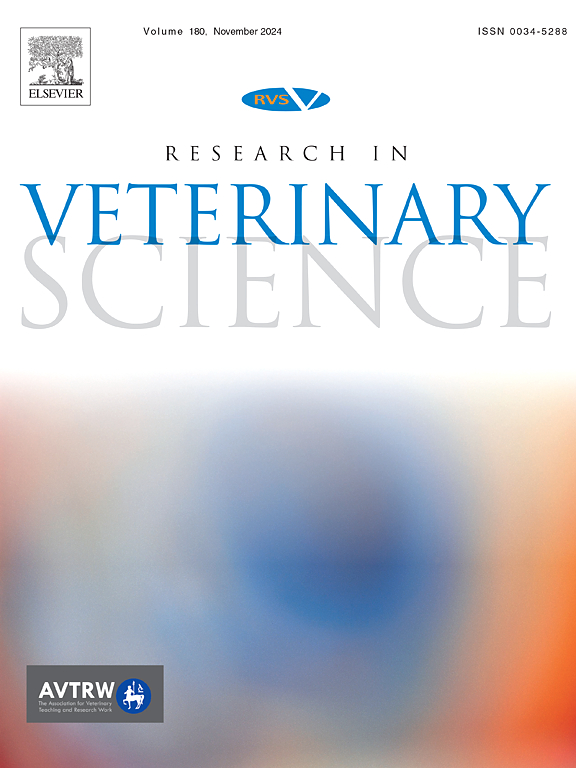奶牛牛奶中碳青霉烯耐药肠杆菌科:系统综述和荟萃分析。
IF 2.2
3区 农林科学
Q1 VETERINARY SCIENCES
引用次数: 0
摘要
在奶牛的牛奶中发现了碳青霉烯抗性肠杆菌科(CRE),引起了人们对公共卫生风险的担忧。本研究旨在通过系统评价和荟萃分析,根据系统评价和荟萃分析(PRISMA)指南的首选报告项目,评估奶牛牛奶中CRE的全球流行程度。最初根据预定义的纳入标准筛选从四个数据库检索到的文章。荟萃分析包括49项研究(2011-2024年),涵盖全球28,134份牛奶样本和3462株肠杆菌科分离物。将全文数据提取到Microsoft Excel电子表格中,并使用R v.4.3.0软件中的“meta”R包进行汇总流行率和亚组荟萃分析,并使用随机效应进行logit转换。采用Cochran’s Q统计量(χ2)、p值和I2统计量评估异质性。采用Egger检验、漏斗图、修剪填充图和留一检验评价发表偏倚和敏感性。在全球范围内,奶牛牛奶中CRE的患病率为0.73% (95% CI, 0.37-1.41)。基于大陆、样本类型、肠杆菌科种类、诊断方法、抗生素类型和解释指南的亚群荟萃分析显示,亚群内各标准间无显著差异。虽然奶牛牛奶中CRE的总体流行率相对较低,但它引起了对原料奶消费的公共卫生关注。这强调需要在“同一个健康”框架下对乳制品行业的CRE进行定期监测,以预测在人、动物和环境之间的潜在传播。本文章由计算机程序翻译,如有差异,请以英文原文为准。
Carbapenem-resistant Enterobacteriaceae from dairy cattle milk: A systematic review and meta-analysis
Carbapenem-resistant Enterobacteriaceae (CRE) have been detected in dairy cattle milk, raising concerns about public health risks. This study aimed to assess the global prevalence of CRE in dairy cattle milk through a systematic review and meta-analysis, following the Preferred Reporting Items for Systematic Reviews and Meta-analyses (PRISMA) guidelines. Retrieved articles from four databases were initially screened based on predefined inclusion criteria. The meta-analysis included 49 studies (2011–2024), covering 28,134 milk samples and 3462 Enterobacteriaceae isolates globally. Data from the full text were extracted to a Microsoft Excel spreadsheet and analysed using the ‘meta’ R package in R v.4.3.0 software for pooled prevalence and subgroup meta-analysis with a random-effects for logit transformation. Heterogeneity was assessed using Cochran's Q statistic (χ2), p-value and I2 statistic. Publication bias and sensitivity were evaluated using Egger's test, funnel plot, trim and fill plot, and leave-one-out test. Globally, the prevalence of CRE in dairy cattle milk was 0.73 % (95 % CI, 0.37–1.41). Subgroup meta-analysis based on continent, sample type, Enterobacteriaceae species, diagnostic method, antibiotic type, and interpretation guideline revealed no significant differences among the criteria within the subgroup. Although the overall pooled prevalence of CRE in dairy cattle milk is relatively low, it raises public health concern regarding raw milk consumption. This emphasizes the need for regular monitoring with in a One Health framework for CRE in the dairy industry to anticipate potential transmission between humans, animals, and the environment.
求助全文
通过发布文献求助,成功后即可免费获取论文全文。
去求助
来源期刊

Research in veterinary science
农林科学-兽医学
CiteScore
4.40
自引率
4.20%
发文量
312
审稿时长
75 days
期刊介绍:
Research in Veterinary Science is an International multi-disciplinary journal publishing original articles, reviews and short communications of a high scientific and ethical standard in all aspects of veterinary and biomedical research.
The primary aim of the journal is to inform veterinary and biomedical scientists of significant advances in veterinary and related research through prompt publication and dissemination. Secondly, the journal aims to provide a general multi-disciplinary forum for discussion and debate of news and issues concerning veterinary science. Thirdly, to promote the dissemination of knowledge to a broader range of professions, globally.
High quality papers on all species of animals are considered, particularly those considered to be of high scientific importance and originality, and with interdisciplinary interest. The journal encourages papers providing results that have clear implications for understanding disease pathogenesis and for the development of control measures or treatments, as well as those dealing with a comparative biomedical approach, which represents a substantial improvement to animal and human health.
Studies without a robust scientific hypothesis or that are preliminary, or of weak originality, as well as negative results, are not appropriate for the journal. Furthermore, observational approaches, case studies or field reports lacking an advancement in general knowledge do not fall within the scope of the journal.
 求助内容:
求助内容: 应助结果提醒方式:
应助结果提醒方式:


